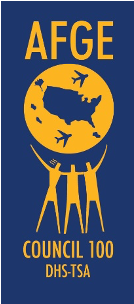We Heard You:
TSO Pay in the President's Budget
Since then, lots of work has been going on behind the scenes to advocate for additional funding in support of a more comprehensive TSO compensation package.
Here’s a closer look at two new initiatives in the President’s FY 2021 Budget, which are a direct result of that effort.
What we heard from you about TSO pay:
- “Pay should match the required abilities and demands of the job”
- “Pay should support career advancement”
- “TSOs should not be stuck at the bottom of the pay band”
The President’s FY 2021 Budget has two new TSO pay initiatives:
- TSO Service Pay: Service Pay recognizes the value that the experienced TSO workforce (TSOs, LTSOs, STSOs, and STI TSOs) brings to the job. It gives TSOs a more predictable system for salary increases over their career. Starting in their third year with TSA, TSOs will receive annual service pay increases of 2% per year for those in the bottom third of the pay band, 1.5% for those in the middle of the band, and 1% for those near the top of the pay band.
- TSO Career Progression “E3” Pay: E3 will provide a significant pay raise for E band TSOs who successfully complete advanced skills training and take on additional alarm resolution duties. E3 TSO will be a new career milestone on the path to LTSO.
Next steps:
TSO Service Pay and E3 Pay in the President’s Budget are part of an ambitious drive to make TSA a better place to work. Together, they represent a big step towards planned pay progression for the TSO workforce. They won’t fix the lack of past pay progression overnight, but they will set TSOs on the right path forward.
Like most ambitious plans, these initiatives will require Congressional support for a significant increase in funding for TSA. The earliest we could fully implement these changes is 2021.
We’re sharing as much as we can now, and we’ll keep you updated on developments.
Looking ahead at the future of TSO pay:
The table below gives a little insight into how TSO pay might change in the future. In order to provide a realistic example that takes into account locality pay, we picked a sample location – in this case, Atlanta (ATL). The table shows how an ATL TSO’s pay would grow over the course of 10 years as they progress from a D band new hire to an experienced E band with advanced alarm resolution skills (keep in mind this is only if Service Pay and E3 Pay are implemented).
The last column shows how Service Pay and E3 Pay would work with Model Officer Recognition pay increases. Federal government-wide pay increases, such as the annual CEI, aren’t included here, but they would mean even more salary increases for our sample TSO.
Questions and Answers:
– When will Service Pay take effect?
If Service Pay is enacted, all E, F, and G band Officers would receive a Service Pay increase in the first quarter of calendar year 2021 (February-March timeframe). After that, Service Pay increases would occur on the employee’s anniversary date of the last increase or, if promoted to LTSO or STSO, on the anniversary date of the promotion.
– What will happen to TOPS cash awards and pay increases?
The salary increase portion of TOPS and STSO/EPMP payouts would be replaced by TSO Service Pay. The cash award portion (one-time bonus) would remain.
– What about other pay increases, such as CEI and Model Officer, do those go away?
TSOs would still receive any Comparability Equivalent Increase (CEI), the annual federal pay adjustment that is authorized at the beginning of the calendar year. Service Pay will not affect that. All Officers would continue to be eligible for salary increases and cash awards through the Model Officer Recognition program.
· How does TSO Service Pay compare with pay under GS Scale?
The General Schedule provides employees with a salary increase every one, two, or three years depending on their position within the pay grade. When designing TSO Service Pay, TSA wanted something that would reward employees for their service each year rather than every two or three years. When you factor in all of the years in which a GS employee does not receive a step increase, the average annual increase works out to be about 1.5% over the 18 years it takes to reach the top of the grade. Over the same number of years, Service Pay increases are comparable or slightly higher.
Last year’s external review of TSO pay by the Blue Ribbon Panel stated that TSA should not move into the General Schedule. Rather, a better course of action would be “to use existing ATSA flexibility to improve the TSA pay system so that it operates at a level superior to the GS system.” ATSA provides TSA significant flexibility in how the mission is accomplished, particularly in how the Transportation Security Officer (TSO) workforce is compensated and human resources services are administered. This enables TSA to remain agile and responsive to mission requirements.
· Why does Service Pay start in year three (i.e. why are D band TSOs not eligible for Service Pay)?
D band TSOs receive a 5% pay increase upon successful completion of their Career Level D2 requirements, and then are eligible for promotion to the E band after approximately one year from that date. Therefore, the increases D band Officers receive during their first 18 months far surpass the annual Service Pay increases.
